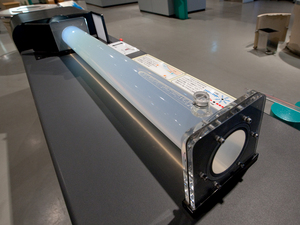Nagoya City Science Museum
TOP > Exhibition Guide > Keyword Search > Starting with "L" > light > Glow of sky
Glow of sky



Purpose of Exhibition
This exhibit is designed to allow you to visually understand what makes the sunrise and sunset glows red and what makes the sky blue.
Additional Knowledge
Liken the source light to the sun and the cylinder to the atmosphere, before you use this device. First of all, check the color of the source light (the sun). Pull the lever in front of you toward you and you will find the source light to be white. Then, push the lever back in and the light will move ahead in the cylinder. Look carefully at the color inside the cylinder. You will notice that the color gradually turns from blue into reddish. In other words, the device shows you the process of how the sky color turns as the source light continues to move ahead in the atmosphere, adding to the distance that it covers in the atmosphere. Shortly before sunset, the sunlight (source light) has already covered a long distance, thus making the sky gradually lose the blue color to take on the sunset glow or the sunrise glow (Figure).Now, check the light that has passed through the cylinder (atmosphere) and you will find the light to be red. In other words, the sinking sun and the rising sun are red because the sunlight has covered a long distance in the atmosphere. The cylinder contains water and acryl emulsion (with a tiny particle size of 0.09μm). When the light hits those particles, “light scattering” occurs and the light is colored. Unless light scattering should occur, the inside of the cylinder would stay colorless and transparent. Light is an aggregation of lights of different colors. In the presence of tiny particles, the reddish light (long wavelength light) easily goes straight and the bluish light (short wavelength light) easily scatters. The blue light scatters in the cylinder, and the non-scattering red light, capable of going straight, eventually comes out of the cylinder. So why does the red light go straight and the blue light scatter? That is because the diameter of those "particles" is shorter than the wavelength of the red light and longer than that of the blue light. Visualize a boat on the surface of the sea. If the sea wave has a long wavelength, it keeps going shaking the boat. But if the sea wave has a short wavelength, it scatters as soon as it bumps against the boat. To sum up the matter, the longer the wavelength of the light is, the less effect the particles have on the light. The particles in this exhibit correspond to the atoms of oxygen and nitrogen, tiny water droplets, dust, etc. in the real-life atmosphere. In the total absence of those tiny particles, we should see the moon and stars up in the dark sky with outer space in the backdrop ‐ even in the daytime. Thanks to the presence of air on our Earth, we can have a clear blue sky that refreshes us and we can live on the Earth. Our awareness of this fact makes us feel something truly special about our existence, doesn't it?Figure: Difference between sunrise/sunset and daytime in the distance that the sunlight covers in the atmosphere. The blue light scatters and disappears by the time the sunlight gets to the points of sunset and sunrise after covering a long distance in the atmosphere.
Article by Shoji Nishimoto, curator
